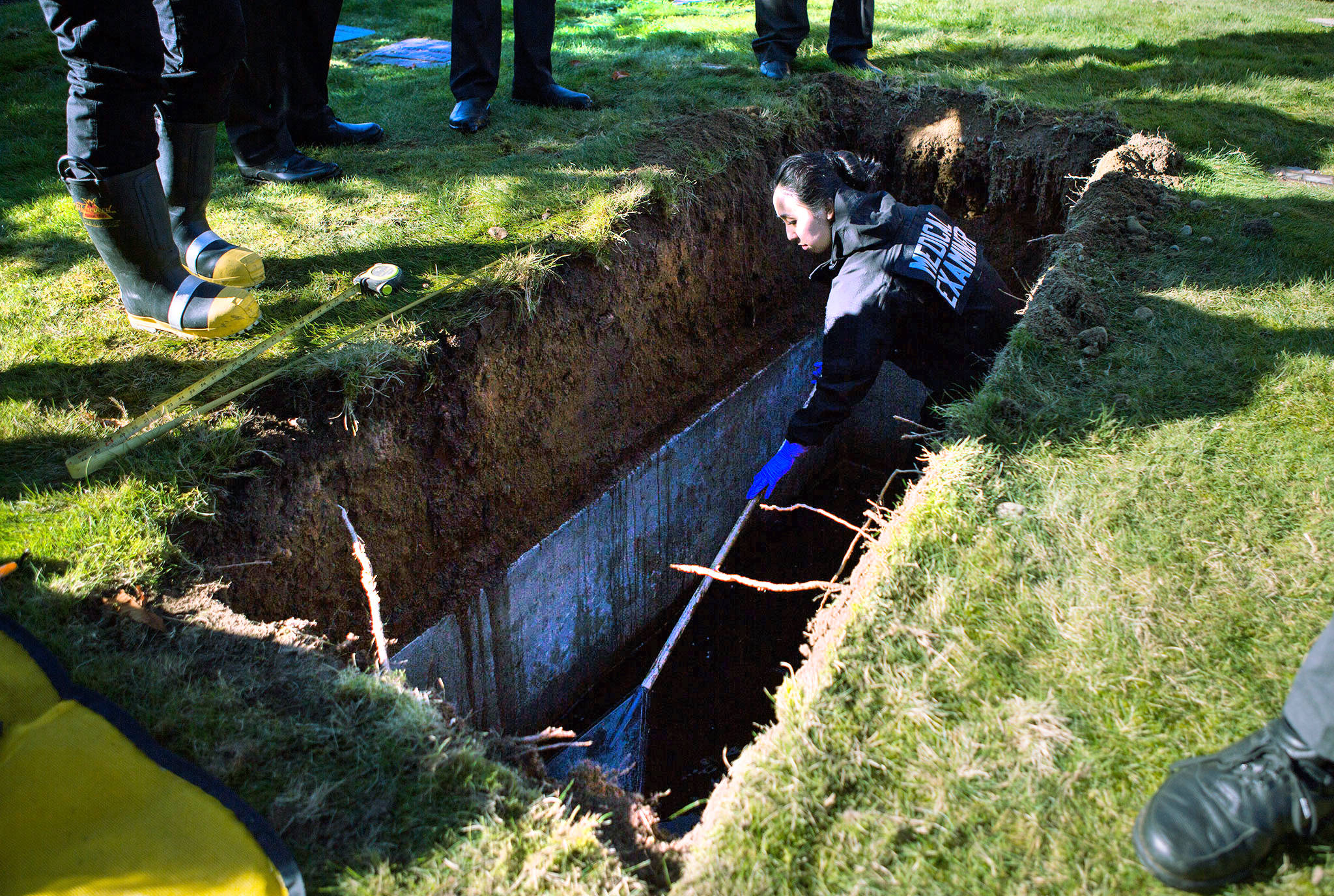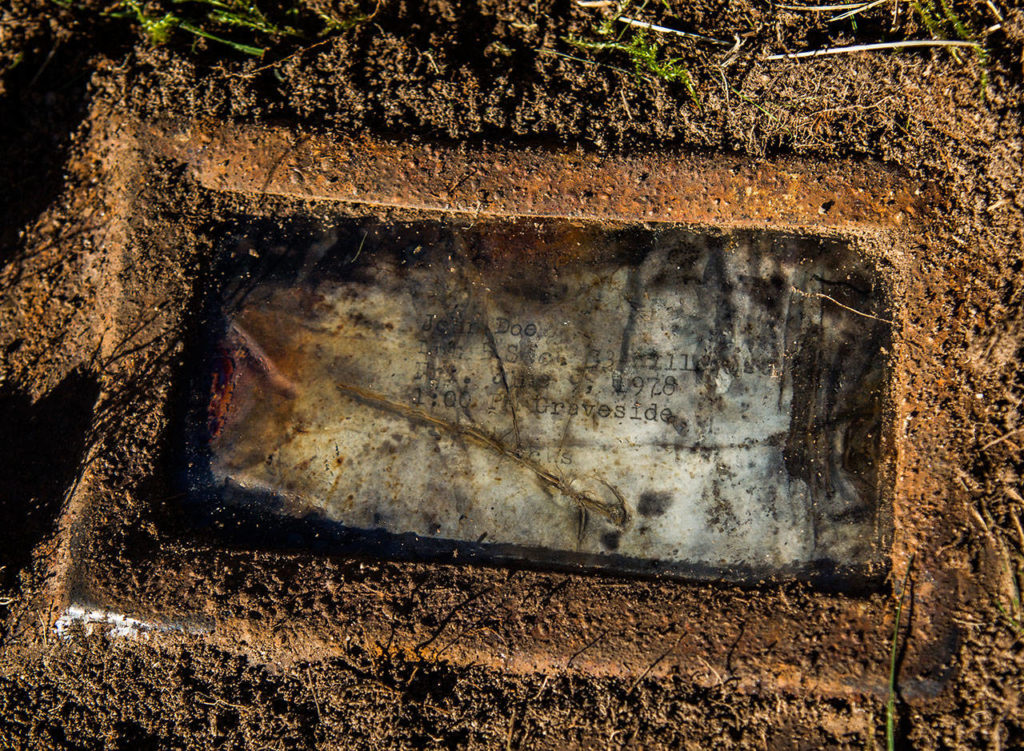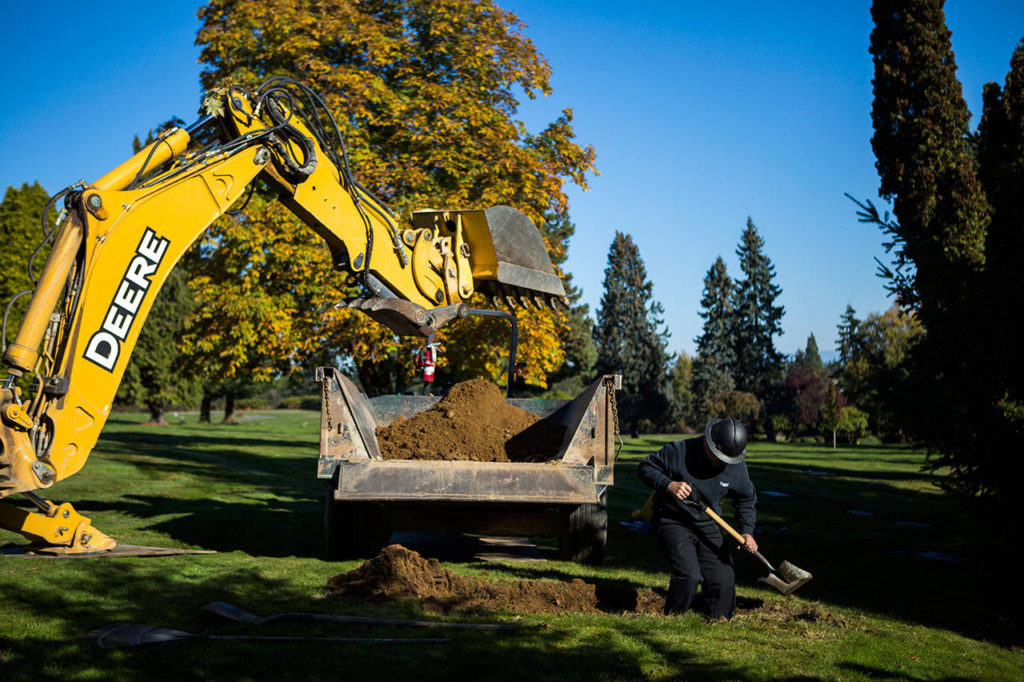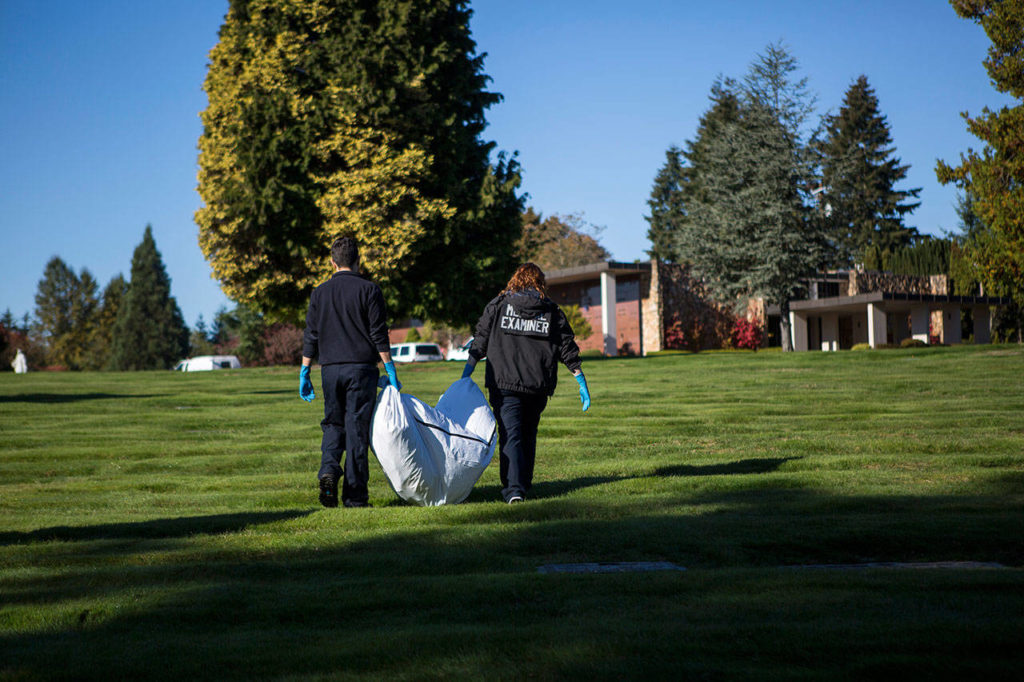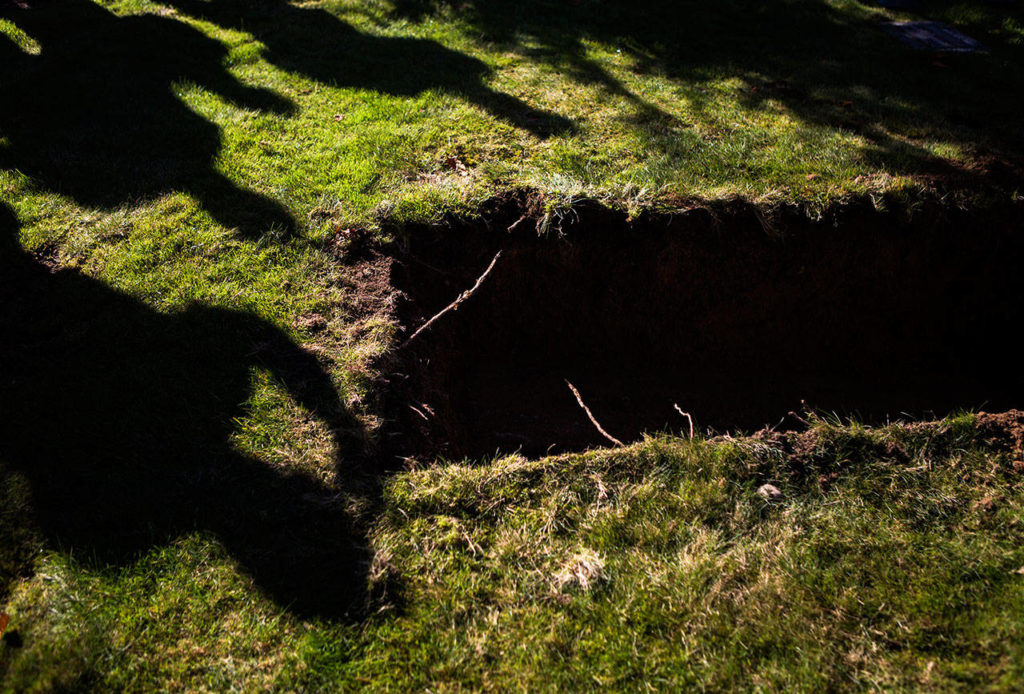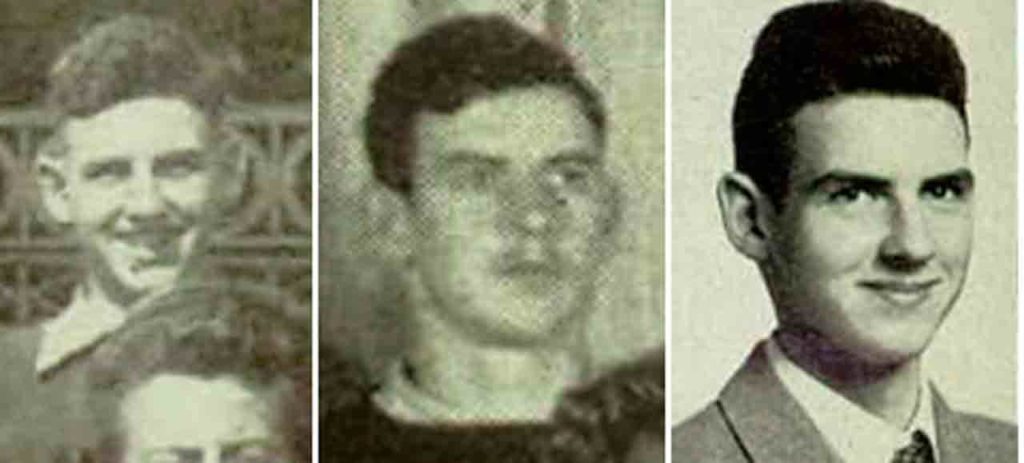Dogs often ran through the field that had a thicket of alders, 1½ miles north of what is now Alderwood mall.
The dogs dug up the bones in January 1978, and carried them to a yard off 164th Street SW. The neighborhood was quiet enough to be called rural in The Daily Herald article, “Human skull discovered under a tree.”
Today, it’s a different place. Road workers rerouted Highway 525 to run along the yard. A bustling Fred Meyer replaced a trailer park across the street.
State highway surveyors who helped turn the woods into suburbia, found more bones in March and April 1978. There were rib bones, back bones and a lower jaw with fillings in the teeth, according to various reports in the case file.
All these years, the skull has waited in evidence at the Snohomish County Medical Examiner’s Office, where the man is known as Lynnwood Bones Doe. He’s one of 13 local cases of unidentified remains that county detectives hope to solve.
Over the past month, a team of cold case investigators has breathed new life into a mystery that is four decades old.
A forensic artist in September used the skull to construct her best estimate of the man’s face. For the first time, detectives and the public were given a rough idea of how this John Doe might have looked.
Other bones were buried at Cypress Lawn Memorial Park in June 1978. Records of what went into the grave, however, have gone missing.
The cold case team did not know what to expect when they unearthed the remains Wednesday.
Broken face
Steady winter rain had washed most of the dirt from the skull, by the time deputies arrived in the 3000 block of 164th Street in 1978. Ditch diggers had been churning up earth all over the neighborhood. Soil tests were not helpful in pinpointing exactly where the bones came from.
“We’ve got nothing to go on at this point,” the county coroner told a Herald reporter, in the article from the time. “We’ve got a skull and that’s it.”
All of the remains found that day were mailed to the Smithsonian Institution in 1978, to be examined by Dr. Douglas Ubelaker. The anthropologist dismissed five samples of mauled bone as white-tailed or mule deer.
Snohomish County cold case detective Jim Scharf cracked open a three-ring binder that holds a few old reports this month, and squinted to read faded photocopies.
“The human skull is well preserved, complete and clean,” Dr. Ubelaker wrote. “Some soil and leaf fragments are adhering to the cranial base, indicating the skull was exposed, resting on its base, in at least a minimally wooded area.”
Ubelaker suggested an age range of 40 to 55.
He had most likely been dead for six months to a year.
Features that could distinguish him were never made public, until now.
Hairline fractures appeared to run across his cheekbones and the left side of the skull, near the left temporal lobe of the brain. In other words, he had a broken face. The fractures were healing, a sign that they were old injuries, from long before his death. Maybe the man was a boxer, Scharf wondered. Maybe he got into a bad fight or a car crash.
Pear-shaped openings of the nasal cavities were “very narrow.” Slight wear on the tongue side of his incisors suggested a marked overbite. An awkward bite could’ve been exaggerated by the loss of teeth. Thirteen teeth, in all, were missing.
A Washington state forensic anthropologist, Dr. Kathy Taylor, examined the skull in 2009. She largely agreed with conclusions from decades ago. The man was almost certainly Caucasian, in his 40s or older, with past head trauma.
Yet how he died is still as much a mystery as his name.
Missing pieces
The bones recovered in spring looked human, according to newspaper clippings from 1978. One article says a mandible was among the later finds.
“I noticed what looked like a jawbone,” a surveyor recounted, in a Herald story. “It had fillings in the teeth. I don’t know too many people who put fillings in their dogs’ teeth.”
A blanket and a man’s clothing were picked up in the area. Detectives figured the bones probably belonged to the same man, since they were uncovered a block or so from the skull. That has never been confirmed by DNA, however.
An investigator from the county medical examiner’s office, Jane Jorgensen, was researching old vital records about three years ago, looking for forgotten unsolved deaths, when she stumbled on the case and found it had been dormant since Dr. Taylor’s exam. Jorgensen discovered the skull in a box, with a note, “John Doe No. 1 – 78.” The sheriff’s office had not worked on the case for many years, because detectives weren’t aware of it, Scharf said.
A records request through Washington State Archives turned up reports on the discovery of the skull. But today’s case file is thin on the dates March 10 and April 11, 1978, when the other bones were found. All photos and police narratives are missing, possibly destroyed. Followup reports might still be somewhere in archives, Scharf said. This month the sheriff’s office asked archivists to search again.
If the reports are gone for good, there’s no inventory of which bones were found, where and how. Any detail that wasn’t released to the press would be lost.
Early in the investigation, a sheriff’s sergeant said the man likely died of suicide or an undetermined cause. The sergeant “quickly dispensed any theories of foul play,” and steered reporters away from suggestions of homicide, according to Herald archives.
“Now, why would they think that?” said Jorgensen, who has been reviewing cold cases with Scharf.
To her, the little evidence in this case file does not reveal a manner of death.
It could be natural, it could be accidental, it could be suicide, or it could be homicide.
The skull had no bullet holes or trauma that could be fatal. But without the rest of the body, it’s impossible to say if this man had other wounds.
Missing man
One handwritten note in the medical examiner’s record is two words in parentheses: (Horace Prescott).
And that’s it. No followup. Nothing to say Prescott had been explored as a possibility, or ruled out — at least not in the surviving records.
But it’s something.
Muster rolls show Horace Jack Prescott Jr., of the Seattle area, served in the Marine Corps Reserves in the mid-1940s. He spent time in veterans hospitals and had a history of mental illness, “with a tendency to wander,” according to his missing person file. He was last seen alive Nov. 15, 1976, at a Seattle hotel when he was in his late 40s.
His father reported him missing in June 1977.
Prescott Jr. was never found.
On the slim chance that he is alive today, he would be 91.
Jorgensen sees it as a lead worth chasing. She navigated genealogy websites, in search of family lines that could lead her to Prescott’s relatives, who could give a DNA sample for comparison.
So far, no luck.
The medical examiner’s office has asked for dental records from the military. Jorgensen wonders if Prescott’s military service could explain the healing trauma to the skull’s cheekbones.
This summer, artist Natalie Murry studied the skull. She glued rubber pegs to the surface, to project tissue depth and to give shape to the face. In her drawing, one eyebrow rests higher than the other. The chin is boxy with a cleft. The lips are full. His right ear is crooked, and lower than the left.
The brown eyes and short dark hair are guesses. It’s not meant to be a photo. All faces have asymmetries and quirks — things family or old friends do not forget. The goal of a reconstruction is to try to bring those traits to life.
Murry drew him looking young.
Jorgensen tracked down Ballard High School portraits of Prescott. She sees a resemblance. The tilt of the ears, the skinny bridge of the nose and the lips — they’re not far off.
“I think so,” Jorgensen said. “The eyebrows are different, but Natalie says eyebrows are hard. It’s a definite possibility, as good as anybody else.”
Unearthing the vault
A grounds crew scraped off bright green grass on a slope at the east edge of Cypress Lawn.
Under a layer of sod, a tiny typewritten grave marker was hidden, with a cracked covering weathered and corroded by 40 winters.
“John Doe.”
A plot number was given, followed by the date of burial.
“Fri. June 9, 1978.”
“1 P.M. Graveside.”
A 6-ton backhoe slid its bucket into the soft dirt around 10 a.m. Wednesday. Within minutes, it touched a tablet as wide as a cot. Death investigators snapped photos. The backhoe pulled out the lid on heavy-duty chains.
In a muddy ankle-deep pool, the bones were soaking in a chamber about 4 feet underground.
Graves often flood here in the rainy season and dry out in the summer. The cycle degrades DNA. To get a good sample from these bones might require advances in technology, Scharf said.
Different labs want different things. One asks for a femur. Another wants a foot bone, a knee cap, teeth — something hard to drill into. Detectives hoped to find any bone with good, intact DNA.
One investigator pulled on rubber boots, climbed into the pit and hoisted long-buried plastic bags full of bones onto a yellow mesh netting, to let the murky water drain. A thin, worn cloth covered with flower print had been buried with John Doe. Bones were loaded into a van bound for the medical examiner’s office, for the task of piecing together the skeleton.
If a lab can pull DNA from the bones, it can be compared against the skull’s DNA, to confirm once and for all it’s the same person. Eventually, the samples could give clues about genetic makeup, like eye color, hair color and ethnic background. And the DNA could point detectives to a family tree, if relatives have uploaded their genetic data to genealogy websites.
Soon a state forensic anthropologist is expected to sift through the bones. Depending on what’s there, she could give an educated guess at the man’s stature, look for signs of trauma and hopefully bring him a step closer to having a name again.
In the meantime, tips can be directed to investigators at 425-388-3845.
Caleb Hutton: 425-339-3454; chutton@heraldnet.com. Twitter: @snocaleb.
Talk to us
> Give us your news tips.
> Send us a letter to the editor.
> More Herald contact information.
